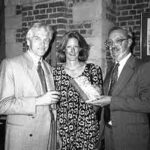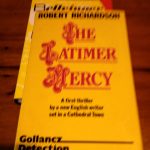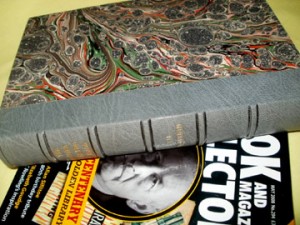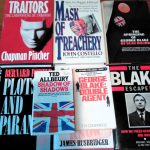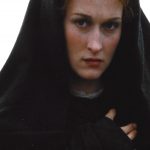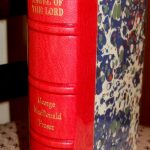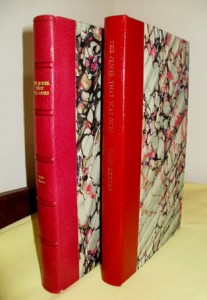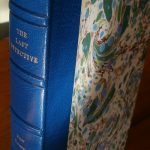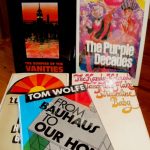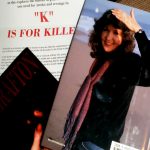The Emergence of Crime Fiction Collecting
- Chapter Headings
The Emergence Crime Fiction Collecting:
Through positioning itself with changes in collecting habits Scorpion Press made a stimulating impact to the collecting of modern first editions in the early 1990s. At that time a small number of booksellers specialised in modern first editions, some viewed the subject as exclusively concerned with literary greats, or its contemporary version with literary writers short-listed for the Booker Prize. Higher end dealers, in London, New York or the West Coast stocked the high spots of popular fiction: ranging from science fiction, fantasy, horror and detective fiction and thrillers. A small select band of pre-war crime writers such as Arthur Conan Doyle, Agatha Christie and Leslie Charteris were sufficiently established and wanted by collectors to be stocked by these bigger dealers. But generally one had to find a specialist in detective fiction for all but a few famous writers. There was interest in Raymond Chandler from the Hollywood films and once the James Bond franchise made an impact with Connery and then Moore in the title role, a collecting boon in Ian Fleming became unstoppable. But the pull toward Bond was balanced in the mid 70s by the weightier anti-hero espionage novels which were growing in popularity by John le Carré, Len Deighton and Ted Allbeury. Together with the horse racing thrillers of Dick Francis, these authors were sought after by collectors for the quality and durability of the writing. Consequently prices began to steadily increase. However, the perennial problem was that the scarcer early books were in such short supply that few collectors could aspire to own a good-looking copy in a jacket of a first edition.
Heroes and Legends on Television:

Three of the authors that the business published in its first year had developed a wider audience or fan base through a successful television series based on their books and the characters they created. Peter Lovesey’s dryly humorous Victorian police detective Sergeant Cribb series made the transition to the small screen in the early 80s, as did Jonathan Gash’s roguish antique dealer Lovejoy which was a sustained success (1986-1994).
But it was at the end of that decade when the viewing public took a huge interest in the Oxford-set television mystery drama Inspector Morse, based of course on the crime novels of Colin Dexter. All three books published in 1991 by Messrs Lovesey, Gash and Dexter, with the distinctive Scorpion features found ready buyers. Soon other established names such as Deighton, Francis, Hill, Rendell and Wingfield were added; some appearing three or more times on the Scorpion list. It is notable that this last group of authors (in addition to the other three mentioned earlier) had all been fortunate to have had television adaptations of their work, which must in turn have boosted their fan base. Wingfield’s copper Frost became over time the most watched television series of all crime dramas – beginning in 1992 to 2009. The authors became legends and the characters heroes.
Inspector Morse was a worldwide television success, repeated almost endlessly, a phenomenon without parallel. (1) Other British crime series followed and although successful, the likes of neither Inspector Wexford nor the revitalised Dalziel & Pascoe (when properly cast on the BBC) never had the same lasting pull or special distinction. Perhaps in response to all this 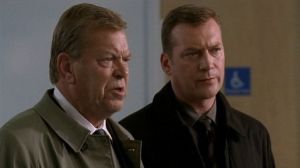 success on screen the Crime Writers’ Association began to invite actors, celebrities and media people to give a keynote speech at its annual award ceremony. A few of the most celebrated that were invited during the 1990s were the late Royal Highness Princess Margaret, the Lovejoy actor Ian McShane. Famous actors frequently put in an appearance at the annual Dick Francis book launch party at the Ritz Hotel, London. And looking ahead to the present, the annual crime novel awards are given at a prestigious London venue jointly with the television crime drama awards.
success on screen the Crime Writers’ Association began to invite actors, celebrities and media people to give a keynote speech at its annual award ceremony. A few of the most celebrated that were invited during the 1990s were the late Royal Highness Princess Margaret, the Lovejoy actor Ian McShane. Famous actors frequently put in an appearance at the annual Dick Francis book launch party at the Ritz Hotel, London. And looking ahead to the present, the annual crime novel awards are given at a prestigious London venue jointly with the television crime drama awards.
Crime fiction ‘new wave’ and TV adaptations:
An upwardly mobile change in collecting detective fiction or crime fiction, as it was now called, was underway. It had gradually become more acceptable to collect contemporary authors, and ownership of a handsome special edition was one way of demonstrating it to friends. But this change of attitude to crime fiction soon spawned another change – the visibility of stronger more visceral crime writers during the 1990s. Once again the publisher responded to what has been called “the new vogue” for  crime fiction (2) by publishing a slew of new generation writers like Lindsey Davis, Minette Walters, Val McDermid, Julia Wallis Martin, Andrew Taylor and Ian Rankin. Rankin grew from small beginnings to be the biggest selling modern crime writer in Britain. The press gave a platform to many of them through its own glossy discussion magazine ‘ Scorpion’.(3) In addition to articles on authors and tips on collecting the fanzine often carried features on television crime series such as Anna Lee, Wycliffe, A Dark-Adapted-Eye, Cracker, Cadfael and Between the Lines. On one occasion it invited the creator of the latter, J C Wiltshire to respond to articles by an ex-policeman and a critic about the programmes.
crime fiction (2) by publishing a slew of new generation writers like Lindsey Davis, Minette Walters, Val McDermid, Julia Wallis Martin, Andrew Taylor and Ian Rankin. Rankin grew from small beginnings to be the biggest selling modern crime writer in Britain. The press gave a platform to many of them through its own glossy discussion magazine ‘ Scorpion’.(3) In addition to articles on authors and tips on collecting the fanzine often carried features on television crime series such as Anna Lee, Wycliffe, A Dark-Adapted-Eye, Cracker, Cadfael and Between the Lines. On one occasion it invited the creator of the latter, J C Wiltshire to respond to articles by an ex-policeman and a critic about the programmes.
Several of these TV series were based on novels, 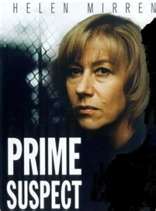 and it was fascinating that post-Morse crime fiction was becoming more layered, intense and creative. One of the most influential was the Prime Suspect series (1991 – 2006) by writer and producer Lynda Le Plante. Detective Chief Inspector Jane Tennison was the first senior female police investigating officer on British television; it made Helen Mirren an international star and the series became a benchmark in television drama for realism, authenticity and for its deft handling of difficult moral issues. All this new energy on screen seems to provide an impetus to writers in the United Kingdom and abroad.
and it was fascinating that post-Morse crime fiction was becoming more layered, intense and creative. One of the most influential was the Prime Suspect series (1991 – 2006) by writer and producer Lynda Le Plante. Detective Chief Inspector Jane Tennison was the first senior female police investigating officer on British television; it made Helen Mirren an international star and the series became a benchmark in television drama for realism, authenticity and for its deft handling of difficult moral issues. All this new energy on screen seems to provide an impetus to writers in the United Kingdom and abroad.
Rebirth of the Gritty Realism in America
Towards the latter part of the 1990s as publishers we began to concentrate more on American hard-boiled crime and thrillers and noted a revived interest in the heirs to Dashiell Hammett and John D McDonald. American crime fiction had been drifting for decades. During the 60-70s most genre writers with talent were on the fringes – writing pulps, TV screenplays or were advised to look elsewhere. One critic noted with irony how idiosyncratic the detective story had become: “In an attempt to restore the genre’s vitality, detectives were given more original, individual characteristics. But what they gained in interest they lost in credibility. Paradoxically, the genre that had began as the most realistic, the closest to life, became the most artificial, the furthest removed from life.” (4) TV series such as McCloud and Columbo were well known examples of such entertainments. At the tail end of the 1980s several authors began to make a distinctive impression with critics and readers, and began revitalising the genre: Carl Hiaasen’s darkly humorous portrayal of Florida in Double Whammy (1987), Jeffrey Deaver produced the Holmes-like detective in wheelchair with Lincoln Rhyme, James Lee Burke’s mafia and misfits in Louisiana with the awarding winning Black Cherry Blues (1989), and James Ellroy’s take on seamy Hollywood in The Big Nowhere (1988) and LA Confidential (1990). It was also at about this time that a bevy of new writers come along: Michael Connelly, Robert Crais, Walter Mosley, Carol O’Connell, and George Pelecanos made significant debuts within a short space of time. All of them were to feature on the Scorpion Press list and since several have not been publicised in the United Kingdom this publisher could take some credit for helping to get them established here. The prolific New York based Grandmaster Lawrence Block has appeared three times and the emergence of James Lee Burke as the towering figure of US hardboiled has been fully recognised in the nine books issued to date.
Another significant change in the American hard-boiled crime scene was the prominence of social, race and gender issues found in the work of female and black writers. The “women on the case” genre came from primarily the crime novels of Sue Grafton, Marcia Muller and Sarah Paretsky. They introduced the female voice as the crime fighting investigator. From 1980s to the present these writers have assisted in a gradual change in the perception of women in popular fiction – they are tough, street-wise and yet are also understanding and compassionate. As well as Sara Paretsky, now a Grand Master, Scorpion Press has published two of the Mallory novels by Carol O’Connell. Kate Mallory is a New York cop whose task is to take on the cops and the criminals and resolve her own demons from the past. For Val McDermid the Mallory character is a revelation.
“Black detectives” became a sub-genre and the background of race issues feature in the work of Walter Mosley, George Pelecanos 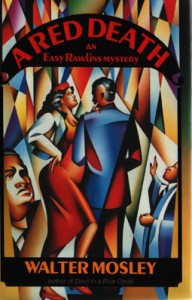 James Sallis, What is particularly noteworthy is that although they work within the crime fiction genre they employ the full range of the novelists skills – comedy, tragedy, melodrama – they mix the cosy middle-class settings with underworld and while they are noir-ish they are never overwhelmed by the material. They have also found it best to convey the narrative through the prism of an enfolding history of modern America. This device adds authenticity, and also allows the reader some distance from the events – perhaps with an eye to retelling the story.
James Sallis, What is particularly noteworthy is that although they work within the crime fiction genre they employ the full range of the novelists skills – comedy, tragedy, melodrama – they mix the cosy middle-class settings with underworld and while they are noir-ish they are never overwhelmed by the material. They have also found it best to convey the narrative through the prism of an enfolding history of modern America. This device adds authenticity, and also allows the reader some distance from the events – perhaps with an eye to retelling the story.
British Noir and Eurocrime Writers
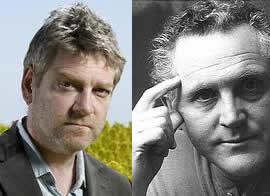 In recent years newer crime writer talent was recognised with novels by British, Irish and Eurocrime writers: among them are Mark Billingham, Ken Bruen, R J Ellory and Mo Hayder, and from Europe – Boris Akunin, Arturo Perez-Reverte, and Henning Mankell. Some of these authors influences has undoubtedly been from the recent American school – Block, Burke, Connolly and Pelecanos which although more socially relevant and critical than before, was now marketed to a mass audience. The other influence was the willingness of some Eurocrime writers to underline personal failings of the protagonist and social disorders as more central to the plot and this position had been pre-figured in the work of some British authors – whom Michael Dibdin, the late Eurocrime writer and critic believed marked a dark psychological and anti-Establishment undercurrent which had always been present in the British crime tradition (e.g. Derek Raymond). (5) A mixture of these forces would echo through the police procedurals of Bruen, Billingham and Hayder. All enjoying success internationally, with adaptations to film and television. Unusually for a British writer, Ellory’s prosaic writing always takes the reader to intrusive underpinnings of American society – and part of its dynamic seems to come from skewing together that country’s great literary and crime traditions.
In recent years newer crime writer talent was recognised with novels by British, Irish and Eurocrime writers: among them are Mark Billingham, Ken Bruen, R J Ellory and Mo Hayder, and from Europe – Boris Akunin, Arturo Perez-Reverte, and Henning Mankell. Some of these authors influences has undoubtedly been from the recent American school – Block, Burke, Connolly and Pelecanos which although more socially relevant and critical than before, was now marketed to a mass audience. The other influence was the willingness of some Eurocrime writers to underline personal failings of the protagonist and social disorders as more central to the plot and this position had been pre-figured in the work of some British authors – whom Michael Dibdin, the late Eurocrime writer and critic believed marked a dark psychological and anti-Establishment undercurrent which had always been present in the British crime tradition (e.g. Derek Raymond). (5) A mixture of these forces would echo through the police procedurals of Bruen, Billingham and Hayder. All enjoying success internationally, with adaptations to film and television. Unusually for a British writer, Ellory’s prosaic writing always takes the reader to intrusive underpinnings of American society – and part of its dynamic seems to come from skewing together that country’s great literary and crime traditions.
In Europe the tradition has also been reworked in re-energising the puzzle book with dash and humour in Perez-Reverte and Akunin. Some of the most trenchant social reality novels have come from the Swede Henning Mankell. The deserved winner of the CWA Gold Dagger with Sidetracked, it was a turning-point in the reception of Scandinavian crime with both readers and 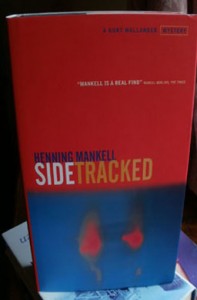 publishers in the Anglo-Saxon world. As a consequence a good deal more European crime fiction was translated into English. Inevitably, “Wallander is one of the great creations of modern crime fiction” said Barry Forshaw, and further “overweight, diabetes-ridden and with all the problems of modern society leaving scars on his soul”. (6) He made it to the TV screens with Kenneth Branagh in the lead; but not before the books had been highly successful in a home-grown Swedish series. ‘British Noir’ and in a different way ‘Eurocrime’ has a distinctive and keen following with readers from around the world.
publishers in the Anglo-Saxon world. As a consequence a good deal more European crime fiction was translated into English. Inevitably, “Wallander is one of the great creations of modern crime fiction” said Barry Forshaw, and further “overweight, diabetes-ridden and with all the problems of modern society leaving scars on his soul”. (6) He made it to the TV screens with Kenneth Branagh in the lead; but not before the books had been highly successful in a home-grown Swedish series. ‘British Noir’ and in a different way ‘Eurocrime’ has a distinctive and keen following with readers from around the world.
Historical Military Adventures of Flashman and Sharpe
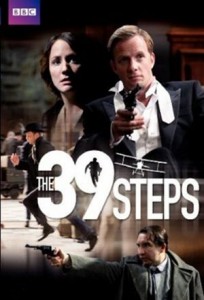 Historical adventures are escapist literature associated over a hundred years ago with the great names of the form known as historical romance such as Tobias Smollett, Sir Walter Scott, R L Stevenson and Rudyard Kipling. That was long before publishers and critics decided on rigid genre demarcations. As a mode of writing it was virtually displaced by the action thriller in the hands of Buchan and his imitators, until C S Forester brought it back into fashion with the Captain Horatio Hornblower R.N. books. This association of historical adventure with military escapades and a hero figure (or anti-hero) was to prove a successful template for the popular fiction of two giants of the form at the end of the twentieth century: George MacDonald Fraser and Bernard Cornwell.
Historical adventures are escapist literature associated over a hundred years ago with the great names of the form known as historical romance such as Tobias Smollett, Sir Walter Scott, R L Stevenson and Rudyard Kipling. That was long before publishers and critics decided on rigid genre demarcations. As a mode of writing it was virtually displaced by the action thriller in the hands of Buchan and his imitators, until C S Forester brought it back into fashion with the Captain Horatio Hornblower R.N. books. This association of historical adventure with military escapades and a hero figure (or anti-hero) was to prove a successful template for the popular fiction of two giants of the form at the end of the twentieth century: George MacDonald Fraser and Bernard Cornwell.
George MacDonald Fraser had served in the Border Regiment in World War II and his love of old-fashioned storytelling and historical incident led him to write instalments in the life of the cad Sir Harry Paget Flashman. Auberon Waugh regarded them as “twice as good as Buchan and twenty times better than Fleming”. (7) The novels are a peek behind the curtain of history, with real historical figures blending in with Flashman’s adventures. They began to appear as far back as 1969 and although several came out more or less every year, by the 1990s new offerings were sparse; the press published two of the adventures – Flashman and the Angel of the Lord in 1994 and what proved to be the last outing, Flashman on the March eleven years later. George MacDonald Fraser died in 2008 and is sadly missed.
 The character of Rifleman Richard Sharpe first appeared in 1981 and the series by Bernard Cornwell has currently reached twenty-one full length books. These adventure tales combine high drama and, love interest with the military action during the Peninsular War through to the Battle of Waterloo. The action blends well into a fully rounded story of human endeavour: showing at times why and how the characters are heroes and villains, through the sieges and escapes, and the friendship and revenge that follow them. The series has a particularly strong following and even has is own fan club, known as the Sharpe Appreciation Society. With the television films Sharpe starring Sean Bean the books reached an even wider audience. Six of the Sharpe adventures, beginning with the first Sharpe in chronological sequence Sharpe’s Tiger have been published and all have sold out except the most recent, Sharpe’s Fury.
The character of Rifleman Richard Sharpe first appeared in 1981 and the series by Bernard Cornwell has currently reached twenty-one full length books. These adventure tales combine high drama and, love interest with the military action during the Peninsular War through to the Battle of Waterloo. The action blends well into a fully rounded story of human endeavour: showing at times why and how the characters are heroes and villains, through the sieges and escapes, and the friendship and revenge that follow them. The series has a particularly strong following and even has is own fan club, known as the Sharpe Appreciation Society. With the television films Sharpe starring Sean Bean the books reached an even wider audience. Six of the Sharpe adventures, beginning with the first Sharpe in chronological sequence Sharpe’s Tiger have been published and all have sold out except the most recent, Sharpe’s Fury.
Sources and References
“New Collectables – The Scorpion Press” in Book and Magazine Collector No 298 pp 12 – 17, September 2008. Article includes a full publication’s list 1991-2009
T J Binyon,Murder Will Out: The Detective in Fiction, Oxford 1989
Martin Breese, Breese’s Guide to Modern First Editions (2000 edition)
Michael Dibdin, The Picador Book of Crime Writing, Picador, 1993
Barry Forshaw (edited), British Crime Writing: An Encyclopedia, Greenwood World Publishing 2009
Barry Forshaw, “Murder Below Zero” in Book and Magazine Collector No 323
G M Fraser, Quartered Safe Out Here, 1995
Mark Sanderson, The Making of Inspector Morse, Macmillan, 1991
- Mark Sanderson, see introduction
- “The New Vogue for Crime Fiction” is the title of the long essay discussing modern crime writers in Breese
- see the entry ‘Scorpion’ in Foreshaw (edited) British Crime etc
- T J Binyon p 45
- M Dibdin
- B Forshaw, “Murder Below Zero”
- Quoted in the frontispiece to Fraser’s autobiography, Quartered Safe Out Here

